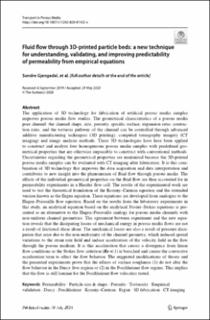| dc.contributor.author | Gjengedal, Sondre | |
| dc.contributor.author | Brøtan, Vegard | |
| dc.contributor.author | Buset, Ole Tore | |
| dc.contributor.author | Larsen, Erik | |
| dc.contributor.author | Åsebø Berg, Olav | |
| dc.contributor.author | Torsæter, Ole | |
| dc.contributor.author | Ramstad, Randi Kalskin | |
| dc.contributor.author | Hilmo, Bernt Olav | |
| dc.contributor.author | Frengstad, Bjørn | |
| dc.date.accessioned | 2021-03-19T11:20:22Z | |
| dc.date.available | 2021-03-19T11:20:22Z | |
| dc.date.created | 2020-09-07T09:48:03Z | |
| dc.date.issued | 2020 | |
| dc.identifier.citation | Transport in Porous Media. 2020, 134, 1-40. | en_US |
| dc.identifier.issn | 0169-3913 | |
| dc.identifier.uri | https://hdl.handle.net/11250/2734444 | |
| dc.description.abstract | The application of 3D technology for fabrication of artificial porous media samples improves porous media flow studies. The geometrical characteristics of a porous media pore channel: the channel shape, size, porosity, specific surface, expansion ratio, contraction ratio, and the tortuous pathway of the channel can be controlled through advanced additive manufacturing techniques (3D printing), computed tomography imagery (CT imaging) and image analysis methods. These 3D technologies have here been applied to construct and analyze four homogeneous porous media samples with predefined geometrical properties that are otherwise impossible to construct with conventional methods. Uncertainties regarding the geometrical properties are minimized because the 3D-printed porous media samples can be evaluated with CT imaging after fabrication. It is this combination of 3D technology that improves the data acquisition and data interpretation and contributes to new insight into the phenomenon of fluid flow through porous media. The effects of the individual geometrical properties on the fluid flow are then accounted for in permeability experiments in a Hassler flow cell. The results of the experimental work are used to test the theoretical foundation of the Kozeny–Carman equation and the extended version known as the Ergun equation. These equations are developed from analogies to the Hagen–Poiseuille flow equation. Based on the results from the laboratory experiments in this study, an analytical equation based on the analytical Navier–Stokes equations is presented as an alternative to the Hagen–Poiseuille analogy for porous media channels with non-uniform channel geometries. The agreement between experiment and the new equation reveals that the dissipating losses of mechanical energy in porous media flows are not a result of frictional shear alone. The mechanical losses are also a result of pressure dissipation that arise due to the non-uniformity of the channel geometry, which induced spatial variations to the strain rate field and induce acceleration of the velocity field in the flow through the porous medium. It is this acceleration that causes a divergence from linear flow conditions as the Stokes flow criterion (Re ≪ 1) is breached and causes the convective acceleration term to affect the flow behavior. The suggested modifications of theory and the presented experiments prove that the effects of surface roughness (1) do not alter the flow behavior in the Darcy flow regime or (2) in the Forchheimer flow regime. This implies that the flow is still laminar for the Forchheimer flow velocities tested. | en_US |
| dc.language.iso | eng | en_US |
| dc.publisher | Springer Nature Limited | en_US |
| dc.rights | Navngivelse 4.0 Internasjonal | * |
| dc.rights.uri | http://creativecommons.org/licenses/by/4.0/deed.no | * |
| dc.title | Fluid flow through 3D-printed particle beds: a new technique for understanding, validating, and improving predictability of permeability from empirical equations | en_US |
| dc.type | Peer reviewed | en_US |
| dc.type | Journal article | en_US |
| dc.description.version | publishedVersion | en_US |
| dc.source.pagenumber | 1-40 | en_US |
| dc.source.volume | 134 | en_US |
| dc.source.journal | Transport in Porous Media | en_US |
| dc.identifier.doi | 10.1007/s11242-020-01432-x | |
| dc.identifier.cristin | 1827624 | |
| dc.relation.project | Norges forskningsråd: 262644 | en_US |
| dc.relation.project | Regionale forskningsfond Midt-Norge: 209074 | en_US |
| dc.description.localcode | This article is licensed under a Creative Commons Attribution 4.0 International License, which permits use, sharing, adaptation, distribution and reproduction in any medium or format, as long as you give appropriate credit to the original author(s) and the source, provide a link to the Creative Commons licence, and indicate if changes were made. The images or other third party material in this article are included in the article's Creative Commons licence, unless indicated otherwise in a credit line to the material. If material is not included in the article's Creative Commons licence and your intended use is not permitted by statutory regulation or exceeds the permitted use, you will need to obtain permission directly from the copyright holder. To view a copy of this licence, visit http://creativecommons.org/licenses/by/4.0/. | en_US |
| cristin.ispublished | true | |
| cristin.fulltext | original | |
| cristin.qualitycode | 2 | |

